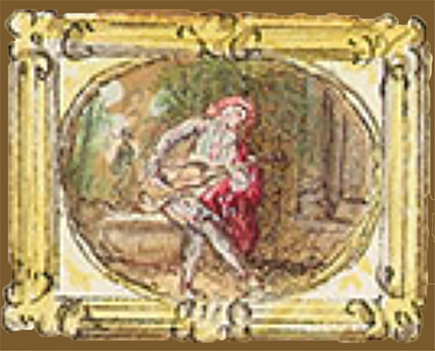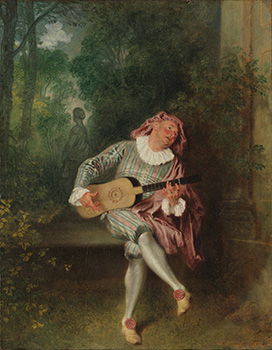
- Home Page
- Accepted
Paintings & Copies - Doubtful
Attributions - Doubtful Textual References
- Alternative
Titles - Collectors &
Museums - Bibliography
- Search Abecedario
- Watteau &
His Circle
Mezzetin
Presumed lost
Oil on panel
18.9 x 24.3 cm
ALTERNATIVE TITLES
Mezetin jouant de la guitarre
PROVENANCE
Paris, with Martn Delahaye. His sale, Paris, January 1, 1754, lot 47: “Un Tableau peint sur bois, représentanr Mezetin, par Vatteau, de 10 pouces de haut sur 7 pouces de large, dans sa bordure dorée.” Sold for 300 livres to Beauchans. The measurements are greater than the paitning,and may reflect the size of the frame.
Paris, collection of Jean de Julliene (1686-1766; director of a tapestry factory). Listed and illustrated in the inventory of his collection now in the Morgan Library and Museum, New York. Cat.157: ”Mezetin jouant de la guitarre par . . . Wateau . . . 23o sur 17o de haut.”
Paris, sale, May 13, 1765, lot 58: “Un tableau représentant un Mezetin, étude de Vateau, sur bois, de 8 pouces de haut, sur 7 pouces de large, dans sa bordure dorée.”
Paris, collection of Madame de Jullienne. Her sale, Paris, November 5, 1778, lot 40: ”un Mezzetin assis et pinçant de la guitare, peint au premier coup sur bois, par Watteau; 9 po. x 7 po.” Sold for 15 livres.
SELECT BIBLIOGRAPHY
Dacier, « Les Pemiers amateurs de Watteau » (1921), 118.
Dacier, Vuaflart, and Hérold, Jean de Jullienne et les graveurs (1921-29), under cat. 215.
Réau, “Watteau” (1928), under cat. 57.
Copenhagen, L’Art français (1935), under cat. 260.
Adhémar, Watteau (1950), under cat. 206.
Eidelberg, Drawings of Watteau (1965), 22-24 ; (1977), i-ii.
Macchia and Montagni, L’opera completa di Watteau (1968), under cat. 193.
RELATED DRAWINGS
Watteau, Mezzetin Seated in a Garden, red chalk, 16.5 x 10.2 cm. Oxford, Ashmolean Museum.

Unidentified French artist after Watteau, Mezzetin, pen and black ink, gray wash, watercolor, underdrawing in black chalk. New York, Morgan Library and Museum, Catalogue des tableaux de Mr. de Jullienne, fol. 72.
We propose that a compositional study in the Ashmolean Museum, Oxford (Rosenberg and Prat R 488) depicting Mezzetin seated on a garden bench, strumming a guitar, is closely related to a picture generally referred to as Madame de Jullienne’s Mezzetin. This painting was recorded first in the catalogue of Jean de Jullienne’s collection and subsequently in that of his widow. It is an oval work. Like the Mezzetin in the Metropolitan Museum, which also was in Jean de Jullienne’s collection, it depicts a Mezzetin in a garden, seated on a bench and strumming a guitar. Because Madame de Jullienne’s picture has remained essentially unrecognized until now, the Oxford drawing was erroneously linked solely to the Metropolitan Museum’s painting.
Importantly, critics have previously been troubled by the apparent discrepancy in date between the Oxford---drawing, an early work—and the Metropolitan Museum’s painting, which dates to the end of his career. However, as Madame de Jullienne’s painting appears to have been an early work, this issue, if anything, strengthens the idea of a relationship between the Oxford drawing and her version of the painting. A major difference between the two is that whereas Madame de Jullienne’s painting was oval in format, the Oxford drawing presents the composition as an upright rectangle.
REMARKS

Unidentified French artist after Watteau, Le Mezzetin, as installed with the Julienne collection, chalk and water color, New York, Morgan Library and Museum.

Watteau, Le Mezzetin, oil on canvas, 55.2 x 43.2 cm.New York, Metropolitan Museum of Art.
Jean de Jullienne’s collection included two similar versions of essentially a single composition, both known as Le Mezzetin. Both depict the costumed figure seated on a garden bench, strumming his guitar and serenading. One version, larger and executed on canvas, is extant in a major collection—the Metropolitan Museum of Art—and is consequently far better known. By contrast, the smaller version, painted on panel, has been largely overlooked by scholars. Its appearance is documented in the illustrated manuscript inventory of the Jullienne collection, and it is described in the sale catalogues of both Jean de Jullienne’s and Madame de Jullienne’s collections.
At the sale of Jean de Jullienne’s collection, the painting was either held back or remained unsold, subsequently reappearing in Madame de Jullienne’s possession. A number of other works suffered the same fate. Although occasionally mentioned in Watteau scholarship, references to the widow’s painting are scarce, both in eighteenth-century sale catalogues and in modern literature. Adhémar, one of the few scholars to acknowledge the painting’s existence, erroneously proposed that it should be identified with Watteau’s Mezzetin now in the Musée Condé, Chantilly. Rather, as the illustrated catalogue of the Jullienne collection demonstrates, the painting in question is closely related to the Mezzetin in the Metropolitan Museum. However, it was smaller than the New York version and executed on panel rather than canvas.
Given the substantial number of small paintings of Mezzetin—purportedly by Watteau—all on panel and measuring approximately 7 by 9 pouces, the eighteenth-century provenance of Madame de Jullienne’s Mezzetin remains problematic. These difficulties are compounded by various errors in the documentation. When the painting was listed in the Morgan Library catalogue, its dimensions were significantly exaggerated, and it was described as taller than wide—despite the illustration clearly showing it to be horizontal.
We have included a painting sold in 1754 which, if correctly identified, constitutes an important clue to the work’s provenance prior to its entry into the Jullienne collection. By the same token, we must exclude references to small panel versions of Le Mezzetin, approximately 7 by 9 pouces, that circulated on the Paris market between 1760 and 1788, since our painting remained with the Julliennes throughout that period.
The fact that Watteau produced so many images of Mezzetin playing the guitar may offer valuable insight into his personal tastes and sensibilities. It serves as an important corrective to the overwhelming emphasis that modern criticism places on Watteau’s depictions of Pierrot.